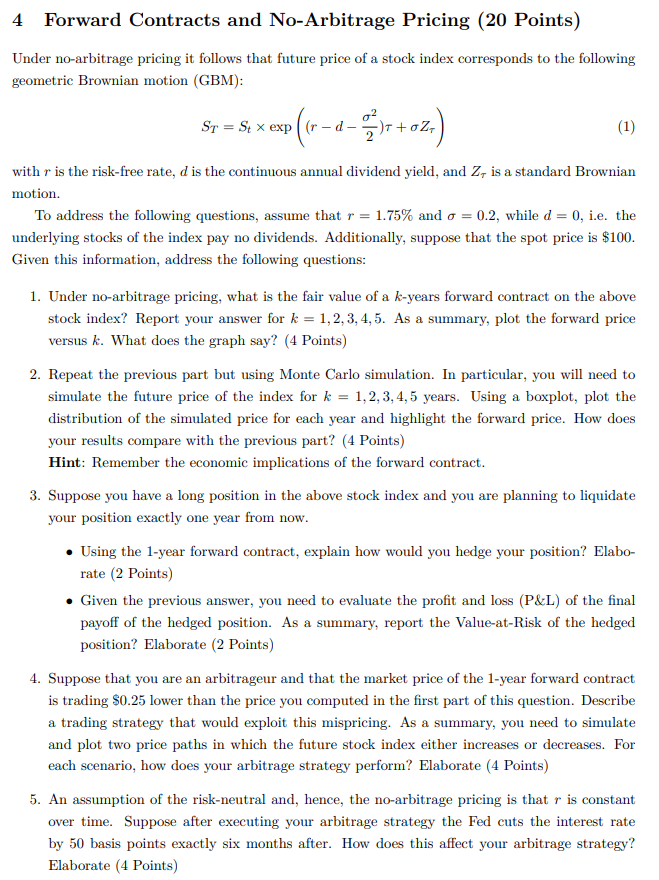Answered step by step
Verified Expert Solution
Question
1 Approved Answer
Forward Contracts and No-Arbitrage Pricing (20 Points) Under no-arbitrage pricing it follows that future price of a stock index corresponds to the following geometric

Forward Contracts and No-Arbitrage Pricing (20 Points) Under no-arbitrage pricing it follows that future price of a stock index corresponds to the following geometric Brownian motion (GBM): ST = Stx exp ((r-d ) + + o Z+) (1) with r is the risk-free rate, d is the continuous annual dividend yield, and Z, is a standard Brownian motion. To address the following questions, assume that r = 1.75% and = 0.2, while d = 0, i.e. the underlying stocks of the index pay no dividends. Additionally, suppose that the spot price is $100. Given this information, address the following questions: 1. Under no-arbitrage pricing, what is the fair value of a k-years forward contract on the above stock index? Report your answer for k = 1,2,3,4,5. As a summary, plot the forward price versus k. What does the graph say? (4 Points) 2. Repeat the previous part but using Monte Carlo simulation. In particular, you will need to simulate the future price of the index for k = 1,2,3,4,5 years. Using a boxplot, plot the distribution of the simulated price for each year and highlight the forward price. How does your results compare with the previous part? (4 Points) Hint: Remember the economic implications of the forward contract. 3. Suppose you have a long position in the above stock index and you are planning to liquidate your position exactly one year from now. Using the 1-year forward contract, explain how would you hedge your position? Elabo- rate (2 Points) Given the previous answer, you need to evaluate the profit and loss (P&L) of the final payoff of the hedged position. As a summary, report the Value-at-Risk of the hedged position? Elaborate (2 Points) 4. Suppose that you are an arbitrageur and that the market price of the 1-year forward contract is trading $0.25 lower than the price you computed in the first part of this question. Describe a trading strategy that would exploit this mispricing. As a summary, you need to simulate and plot two price paths in which the future stock index either increases or decreases. For each scenario, how does your arbitrage strategy perform? Elaborate (4 Points) 5. An assumption of the risk-neutral and, hence, the no-arbitrage pricing is that r is constant over time. Suppose after executing your arbitrage strategy the Fed cuts the interest rate by 50 basis points exactly six months after. How does this affect your arbitrage strategy? Elaborate (4 Points)
Step by Step Solution
There are 3 Steps involved in it
Step: 1
Answer 1 To calculate the fair value of a kyears forward contract on the stock index we can use the formula provided in the question FtTSterdfrac sigm...
Get Instant Access to Expert-Tailored Solutions
See step-by-step solutions with expert insights and AI powered tools for academic success
Step: 2

Step: 3

Ace Your Homework with AI
Get the answers you need in no time with our AI-driven, step-by-step assistance
Get Started


